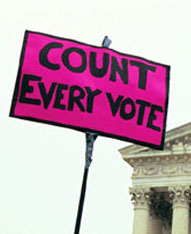Presidential Election Process Activity: Teacher Version

Activity Overview
Students will examine the presidential election process established by the United States Constitution. Students will then analyze the 2000 presidential election as a case study of this process.
Activity / Procedures
Part I: The Electoral College Process
- Explain to students that they will examine how the election process for U.S presidents works. The teacher can also explain that after students have a good understanding of the Electoral College process, they will examine the 2000 presidential election.
-
Introduce the election process by showing the “Flocabulary” rap song video about the presidential election process.
The Presidential ElectionNote: You will need to sign up for a free trial to view the video.
Because students are often confused about what an “Electoral College” is, the teacher should also show a video clip from the National Archives that explains what the Electoral College is and what electors are.
What is the Electoral College?As needed, use the U.S. Electoral College Teaching Resources to reinforce understanding of the Electoral College process.
- Ask students to explain the difference between the popular vote and the Electoral College vote.
- Divide students into small groups, and distribute chart paper and markers. Explain to students that they will conduct a brief research project in order to create a flow chart explaining the presidential election process.
- Provide students with textbooks and/or computers with Internet access to conduct their research. Explain to students that they should include at least eight major steps in the presidential election process. Have students use the following resources to get started with their research:
Infographic: The Electoral College
Ben’s Guide to U.S. Government - Election of the President and Vice President: Electoral College - Have students share their charts with the class and post them around the room.
- Facilitate a discussion reinforcing understanding of the Electoral College process and the difference between the electoral vote and the popular vote.
Part II: The 2000 Presidential Election
- Explain to students that the 2000 presidential election was the closest election since 1876 and only the fourth election in which the electoral vote did not reflect the popular vote.
- Introduce the 2000 election by showing the Presidential Election Process video clip.
- Because it was such an important election, students will create a presentation explaining the major events of the 2000 election, with a focus on the Electoral College versus the popular vote; the recounts in Florida; James Baker’s role; and the Supreme Court case Bush v. Gore. Have students use the following resources to get started with their research:
Landmark Cases: Bush v. Gore
270 to Win: 2000 Presidential Election
2000 Events Timeline – Post Election
Election 2000 – C-Span Video - Student presentations may be in the form of, but not limited to, a PowerPoint, a Prezi, a news broadcast or an infographic.
- Students will present their final products to the class.
Extension Activity
Point out to students that the 2000 election was not the only controversial election in U.S. history. The House of Representatives have had to decide several elections. In other cases the winner won the electoral votes, but not the popular votes.
Explain to students that they will examine in further detail several controversial elections, considering both the positive and negative aspects of the Electoral College. Tell students that they will take a position regarding the future of the Electoral College.
Students will need computers and Internet access to complete the learning module about the Electoral College.
Resources
The Electoral College: Unusual Presidential Elections slideshow
This brief slideshow highlights three unusual elections:
- 1824 Jackson v. Adams
- 1876 Hayes v. Tiden
- 1888 Harrison v. Cleveland
For details about each, refer to the following resources:
- 1824 Presidential Election
- 1876 Presidential Election
- 1888 Presidential Election
- Carter-Baker Panel Calls for Voting Fixes
This 2005 article highlights a joint effort by former President Carter and James Baker to make significant changes in how Americans vote.
Grade Bands:
9-10, 11-12
Approximate Time:
2 days
Objectives:
Students will be able to:
- Describe the Electoral College process.
- Identify major events in the 2000 presidential election.
- Explain James Baker’s role in the 2000 presidential election.
Materials / Media
- Computer with projection device:
James Baker website - Chart paper
- Markers
- James Baker documentary video clip:
Presidential Election Process video clip - Student Activity
Standards
Social Studies College, Career, and Civic Life Standards (C3)
Individually and with others, students
- D2.Civ.4.9-12 - Explain how the U.S. Constitution establishes a system of government that has powers, responsibilities, and limits that have changed over time and that are still contested.
- D2.Civ.5.9-12 - Evaluate citizens’ and institutions’ effectiveness in addressing social and political problems at the local, state, tribal, national, and/or international level.
- D2.His.1.9-12 - Evaluate how historical events and developments were shaped by unique circumstances of time and place as well as broader historical contexts
- D2.His.3.9-12 - Use questions generated about individuals and groups to assess how the significance of their actions changes over time and is shaped by the historical context.
- D3.1.9-12 - Gather relevant information from multiple sources representing a wide range of views while using the origin, authority, structure, context, and corroborative value of the sources to guide the selection.
- D4.1.9-12 - Use writing, visualization, and speaking to construct arguments using precise and knowledgeable claims, with evidence from multiple sources, while acknowledging counterclaims and evidentiary weaknesses.
- D4.2.9-12 - Construct explanations using sound reasoning, correct sequence, examples, and details with significant and pertinent information and data, while acknowledging the strengths and weaknesses of the explanation given its purpose.

